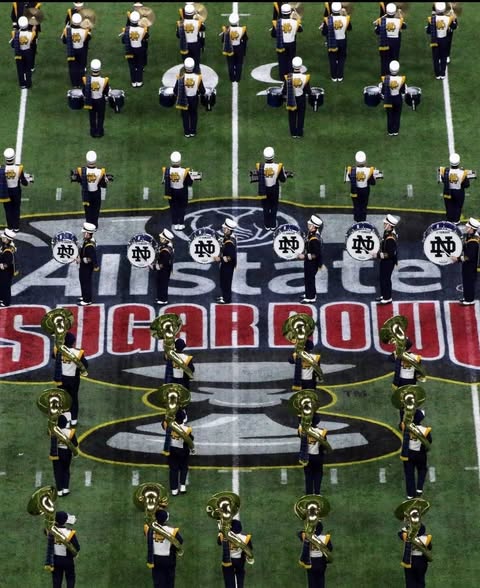In a sweeping celebration of heritage, music, and modern innovation, the University of Notre Dame’s Band of the Fighting Irish has carved out a new place in history. The beloved collegiate marching band has become the first in the nation to receive a Certified Gold distinction on Spotify. Their breakthrough came through the soaring popularity of their original album Echoes of the Dome, which recently surpassed the 500,000 streams threshold—earning the band a Gold certification under Spotify’s recognition program.
With 2.6 million monthly listeners and growing, the Notre Dame marching band has not only redefined what a collegiate ensemble can achieve, but also drawn widespread attention from across the musical world. This accomplishment is more than a digital milestone; it’s a testament to the enduring power of tradition fused with contemporary creativity.
The Historic Achievement
While individual artists and pop bands frequently dominate streaming services, the idea of a university marching band charting in such platforms was once unthinkable. Yet, Echoes of the Dome shattered expectations from the moment of its release. Crafted entirely by the university’s own students, alumni composers, and faculty contributors, the album represents a blend of classical marching themes, Notre Dame fight songs, modern orchestration, and cinematic storytelling.
By Spotify’s standards, a “Certified Gold” honor is reserved for music projects that surpass 500,000 verified streams—a mark historically reserved for prominent names in pop, hip-hop, and alternative rock. For a marching band—traditionally thought of in the context of football halftime shows and campus parades—this represents a seismic cultural shift.
“We always believed our music had soul,” said Dr. Kenneth Dye, Director of Bands at Notre Dame since 1998. “But to see it resonate globally, to the point where millions are engaging with our sound every month, it’s humbling and invigorating. This is a win not only for us, but for collegiate bands everywhere.”
The Rise of “Echoes of the Dome”
Released quietly just ahead of the 2024 football season, Echoes of the Dome was initially intended to commemorate the 180th anniversary of Notre Dame’s founding. The project included fan-favorite classics like “Victory March” and “Hike, Notre Dame,” along with newer compositions like “Golden Visions” and “Cathedral Skies”—orchestral pieces inspired by the university’s basilica and Grotto of Our Lady of Lourdes.
What caught listeners’ ears, however, was the album’s mix of powerful instrumentation and rich storytelling. Tracks layered the trumpet calls with narration snippets from historic campus speeches, crowd chants from Notre Dame Stadium, and even the ringing of the Sacred Heart Basilica bells. These flourishes turned the album into an immersive experience that transcended mere performance and captured the essence of Notre Dame spirit.
College football fans embraced the album initially, but soon playlists curated for workouts, study music, and even movie soundtracks picked it up. One track, “Midnight Drummers Under the Dome,” went viral on TikTok after being used in a highlight reel of college admissions acceptance videos, gaining over 50 million views and pushing the song to Spotify’s “Classical Crossover” top charts.
Marching to a New Beat
The Notre Dame Band, formed in 1846, is the oldest university band in continuous existence in the United States. Its legacy has long been celebrated on campus and throughout the college football world, but rarely has it found such resonance on a mainstream platform. With Echoes of the Dome, the band has not only modernized its sound but effectively rebranded what it means to be a collegiate musician.
The record’s success has led to new opportunities. In early May, Spotify invited the Band of the Fighting Irish to participate in a future “Spotify Sessions” event in New York City—the first time a university ensemble has been tapped for the artist showcase series. The band is also reportedly in talks to record a second album titled Cathedrals and Champions for release in 2026.
Notre Dame’s College of Arts and Letters has lauded the band’s success as “a shining example of what the integration of art, technology, and university spirit can achieve.” Meanwhile, prospective students across the nation are citing the band’s rising profile as a reason for applying to Notre Dame, further emphasizing the role of cultural relevance in university recruitment.
Cultural Impact and Recognition
In recognition of this milestone, Notre Dame held a formal ceremony at the DeBartolo Performing Arts Center, where Spotify representatives presented a Gold Plaque to the Band of the Fighting Irish. University President Rev. John I. Jenkins, C.S.C., lauded the band for “reaching beyond the shadow of the Golden Dome to cast a light around the world.”
During the ceremony, members of the band performed a live medley of the album’s highlights, accompanied by video montages of past performances, footage of the Notre Dame campus, and testimonials from alumni worldwide. The emotion in the room was palpable.
“We always say music is a universal language,” said band senior drum major Elise Walsh, “but now we’ve seen it firsthand. Whether you’re from South Bend, Sao Paulo, or Seoul, the sound of the dome connects us all.”
Notre Dame’s alumni network also took notice, with notable graduates in Hollywood and the music industry praising the band on social media. Actress and Notre Dame alumna Molly Hagan tweeted, “The Dome echoes far and wide. Proud to see the band shining!”
A Gateway for Other Marching Bands?
Following this achievement, other university marching bands are taking note. Programs at Michigan, USC, and Ohio State have all reportedly initiated internal discussions on producing and distributing original albums or remastered performance collections on digital platforms.
Music industry insiders see this as a new frontier for collegiate ensembles. “There’s a growing appetite for orchestral and instrumental music that feels emotional and epic,” said Bryant Carter, an executive with Universal Music Group. “Notre Dame’s band has proven that you don’t need a pop star to go viral—you need a powerful story and resonant sound.”
Some even believe this could lead to Grammy consideration in future years under categories like Best Contemporary Instrumental Album or Best Arrangement, Instrumental or A Cappella.
The Future of the Fighting Irish Sound
As Notre Dame looks to the future, plans are already underway to expand the band’s digital footprint. The university’s IT department is collaborating with the College of Engineering and the Band Office to develop a VR-enabled concert experience for Oculus platforms, enabling fans to experience halftime shows and concerts as if they were on the field.
In addition, an upcoming documentary titled March On: The Sound of Notre Dame is set to premiere in fall 2025. The project will chronicle the making of Echoes of the Dome, the legacy of the band, and its unexpected rise in global popularity.
“Nothing replaces the energy of being in Notre Dame Stadium on a game day,” said Dr. Dye. “But what we’re doing now is giving people a little piece of that feeling, wherever they are.”
More Than Just Music
Ultimately, the band’s success is about more than numbers or certifications. It’s about connection, perseverance, and the timeless value of art grounded in tradition. As the world grows increasingly digital, institutions like Notre Dame are proving that legacy and innovation need not be at odds—they can march side by side, in rhythm.
For Notre Dame students, alumni, and fans, Echoes of the Dome represents a bridge between the past and future—a musical monument to the spirit of the university and a celebration of what it means to belong to something greater.


